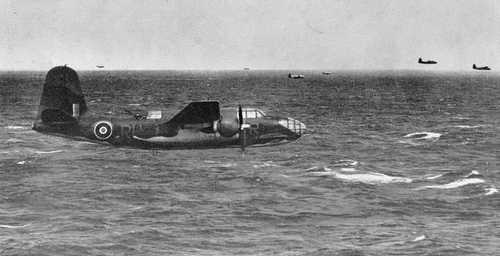
British Forces
Surfin the waves
http://www.vintagewings.ca/VintageNews/Stories/tabid/116/articleType/ArticleView/articleId/325/language/en-CA/Lower-than-a-Snakes-Belly-in-a-Wagon-Rut.aspx
For many attacking aircraft, safety lay down low in the wave tops beneath enemy radar coverage. Here, a squadron of Douglas A-20 Boston bombers of the RAF's 88 Squadron head to the target over the North Sea. 88 Squadron crews became highly proficient in low-level bombing. In December 1942, almost 100 aircraft from 2 Group attacked the Philips Valve Factory at Eindhoven including 12 Bostons from 88 Squadron at RAF Swanton Morley. They were led by W/C Pelly-Fry, the CO of 88 Sqn. Pelly-Fry's aircraft was hit just after he had released his bombs. With much-reduced hydraulic pressure, a large hole in the starboard wing and a coughing and spluttering starboard engine, he narrowly avoided the rooftops but found that the aircraft could not climb above 800 ft, nor could he keep up with the others on the way home. Despite his difficulties, he fought off two FW190s before eventually managing a belly-landing back at Oulton. Deservedly, he was awarded a DSO; the raid also resulted in the award amongst the other crews of another DSO, two DFMs and eight DFCs. But not all the low-flying was "in the face of the enemy". A former 226 Squdron flight commander, a navigator, related to me one such series of antics by which his crew 'nearly came a cropper'. The pilot and captain of his Boston was Sqn Ldr Shaw Kennedy (who became, after the war, the Air Attache in Prague). Kennedy was a brash Irishman with a wild and wicked sense of humour. His favourite jolly jape was to buzz the German and Italian prisoners of war working the fields around the perimeter of Swanton Morley airfield. At this point in the story, it helps to understand that Swanton Morley airfield is situated on the top of the only significant hill in central Norfolk. Despite being a mere 150ft or so above sea level, the ground falls away significantly on the north and eastern edges of the airfield into the valley of the River Wensum. Kennedy's "standard approach" was from the east, hugging the bottom of the river valley before banking sharply to port and roaring up the slope at full power over the startled POWs, who immediately hit the dirt to avoid getting a haircut. Kennedy would then stay low, heading south across the grass airfield, before banking steeply to port again across a small pond, surrounded by trees, to the south of the hangars. He would shave the tops of the trees which, to this day, are shorter in the middle than at the outside, due to his "pruning". This unorthodox procedure worked fine until one, almost fateful, day. As Kennedy rolled out of the left bank to scare the POWs again, his navigator (sitting in the nose) noticed that the POWs had all ducked down well before the Boston would be on them. Sensing that the POWs were up to something, he had no time to tell Kennedy to pull up as all the POWs threw their farming tools in the air as high as they could - straight into the path of the Boston. There were fleeting visions of rakes and spades flashing over the wings and the faint ping of something ricocheting off a prop. Fortunately, Kennedy managed to land the Boston safely. He never buzzed the POWs again! (Story from Squadron Leader Alan. R. James (Ret'd) greetz,brummbar
2655 Views
9/7/2012
